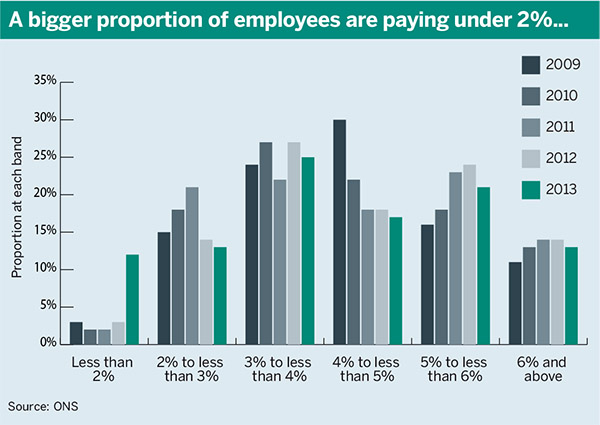In the first quarter of 2015, our debate panel members explain their hopes, concerns and predictions for defined contribution savers and their schemes in the year ahead.
 This is an election year. What is your biggest hope for a new government’s pension policy that will benefit DC savers?
This is an election year. What is your biggest hope for a new government’s pension policy that will benefit DC savers?
Steven Charlton: My hope is that any new government will appreciate the scale of work that has been placed on all pension schemes and that it will allow some time for this work to settle. I would love to see sponsors of workplace pension schemes, and the industry, given greater leeway to be able to communicate the new freedoms to savers in innovative ways without the threat of falling foul of legislation.
Mike Spink: There is a need to investigate appropriate ways of ensuring more people understand the importance of planning for retirement. Pension Wise should be a helpful start – but all practitioners agree that employees need to be preparing their retirement plans much earlier than the typical age – 55 or later – when Pension Wise might be accessed.
Richard Butcher: The legislative and regulatory framework has been radically overhauled during the life of this parliament.
Many of the reforms promised or delivered have yet to be fully defined, let alone implemented and tested. As a consequence, the policy that will give the biggest benefit to defined contribution mastertrust savers will be one of ‘do nothing’.
Andy Dickson: Some stability would be good. There is no doubt appetite in all the political parties for further intervention in pension policy such as changes to tax relief. However, further changes that directly affect consumers and will impact the messaging on workplace pensions, just as the auto-enrolment programme captures small and micro-employers, is unlikely to be helpful.
Ian McQuade: Ideally, I would like to see a cross-party consensus on the future strategy for long-term savings, including pensions.
In their own right, auto-enrolment and freedom-and-choice both have positive aspects, but they have different base assumptions and may act against each other. A gradual increase of savings rates is going to be important for outcomes, but less so for low earners. Otherwise, is some stability to allow the current changes to be implemented too much to ask for?
Nigel Aston: We also hope for a period of regulatory stability. Auto-enrolment is in full swing and achieving great improvements in participation; the ‘freedom and choice’ reforms have given savers more flexibility over how they use their assets in retirement; the charge cap should help ensure that all members, even those in smaller schemes, get better value for money. The next challenge is to bed down these reforms and make them work for savers.
David Robbins: First, do no harm – avoid ill-thought-through reforms to tax relief or ways of letting people dip into their pensions before 55. On minimum contributions, Steve Webb wants automatic escalation discussed early in the new parliament. The Treasury may be in less of a hurry. The attraction of ‘getting Britain saving again’ will be weighed against the short-term consequences for the public finances and living standards if more taxed salary becomes tax-relieved pension contributions.
Anna Compton: The obvious infrastructure challenges aside, it would be in member’s favour to have some sensible timescales for the implementation of a system of ‘pot follows member’, ending the proliferation of ‘stranded pots’.
It might also be worthwhile for the new government to take a look at what can be held in income drawdown. For example, in Ireland only qualified investments can be held. This would obviously require a period of discussion and debate, but it may ultimately be in members’ interests to clarify holding categories.
What is your greatest concern for DC savers from a new government?
Aston: We have a fear that politicians of all stripes may find it hard to resist further tinkering for short-term political benefit. Changes to pension tax relief are an obvious target, but there may also be temptations to introduce further well-meaning governance requirements on schemes, which nonetheless raise costs for sponsors and push them towards doing the minimum allowed by law rather than what is best for their members.
Compton: Getting the balance of regulation right represents a major concern. If the regulation around pensions liberalisation becomes too lax it could lead to mis-selling. But if the regulation becomes too heavy handed, it could lead to member inertia and a preference to just take the easy option of withdrawing cash upon retirement. Overbearing regulation also chokes product innovation, restricting access to new choices that could aid members.
Charlton: My biggest concern is that generations of pension savers who now have access to their accumulated pensions wealth in ways that were not previously available will be confronted with an array of offers that may not be in their best interests. Giving employers and providers the ability to communicate properly, along with the help offered via the guidance guarantee, will give employees a better chance of retirement success.
Butcher: The biggest concern is that a new government continues to create change. While radical reform is unlikely, tinkering is highly likely. The system will not be perfect once the current reforms are in place, but let’s wait until then to make further change.
McQuade: Forcing all employees to pay much higher contributions into schemes will alienate those who are saving for the first time. We need to see how the increases to auto-enrolment contribution levels, due in 2017 and 2018, are received first, and then look at where to go next.
Dickson: Low costs are a focus in DC, resulting in the charge cap. With the new investment freedoms, it has already been suggested these cost-curbs should also be imposed in the post-retirement world. However, if higher fees are associated with a superior investment approach and lower risk outcomes and this can be of material benefit to the saver, more than compensating for higher costs, then that is a concern if we price out what is in fact better value for consumers.
Robbins: Whoever is in power will have a fiscal hole to fill. Changes to tax relief on pension contributions will at least be considered. Even without root-and-branch reform, the next government may need to stop over-55s from avoiding tax by repeatedly diverting up to £10,000 of salary into a ‘pension bank account’ and quickly withdrawing it. Unfortunately, all of the obvious solutions create their own problems.
Spink: My principal wish here is that the incoming government will think very carefully before attempting to make any substantial changes to the latest sets of legislation.
Pension providers are clearly struggling to keep up at present and one can already see the April headlines in the financial pages: “Thousands let down by insurers slow to adapt to new flexibilities.” Too many people still have a poor perception of pensions, and burdening already stretched providers with further change or backtracking on the current administration’s plans won’t help anyone.
How is the DC landscape going to change after April?
McQuade: For some members, the new freedoms will bring greater flexibility to adapt their pension savings to meet their needs. For those reaching retirement with debts, it might give them a chance to enter the next phase of their life debt-free. That may leave them without private pension provision, but at least they will know where they stand. For many, the jury is still out.
Robbins: The new flexibilities should make employer pension contributions a more valued benefit, especially for older workers. Employers’ pension costs will rise if there is greater take-up of matching contributions. Where workers choose to spend their savings early, not even the best pension provision will ensure that they can afford to retire. Most large DC schemes are already cap-compliant, but will a 0.75 per cent cap be the final word?
Butcher: The freedom-and-choice policy was launched without the benefit of evidence or consultation, so the jury is now out until implementation. In addition, the charge cap, while on the face of it positive, could have unintended consequences – for example, less diversification in investment strategies. One thing is for sure, the new landscape is fresher, it’s newer. It will lead to different outcomes.
Aston: Trustees will need to consider whether their default strategies match likely member behaviour and most will see a need to revise the strategy to be appropriate over time for members keeping their assets invested after retirement. A few may look to offer members the opportunity to draw down their assets ‘in plan’, while most will direct their retiring members to mastertrusts and platforms able to offer a wider range of drawdown options.
Charlton: On the charge cap, I suspect this will not concern many of the largest DC schemes, who have the scale to work easily within the cap, and many of the very smallest employers, who auto-enrol and have a whole market of low-cost providers from which to select. Those that sit in the middle of this range will have the most to contend with.
Spink: The principal change I expect to see this year is a significant increase in employee engagement with their workplace pension. Employers, trustees and service providers will become inundated with requests from both active and deferred members eager to understand what their scheme will permit and how the default investment option is being reviewed so as to be fit for purpose.
Dickson: Fiduciaries of DC schemes are prioritising complying with the charge cap, and default investment strategies will reflect this. We are already seeing diversified growth funds at the top end of the fee scale being replaced with our lower-cost option. The next challenge will be redesigning the investment strategy to support freedom and choice. The final stage of the default strategy is key.
Compton: We expect three key changes. New asset allocation solutions will need to take account of changing retirement patterns, as people choose to work part or full-time after retirement, or extend their retirement date. Charges will continue to take centre stage, with one likelihood being the extension of the charges cap into the post-retirement phase. Thirdly, annuities will continue to evolve, with the possible inclusion of longevity insurance vehicles and different income profiles.
Is the FCA’s second line of defence, together with Pension Wise, enough to deliver good outcomes? What else should be done?
Robbins: Some bad outcomes are unavoidable. Managing your money over a lifetime of uncertain length is hard, even before cognitive decline sets in. Many of the first ‘liberated’ retirees have significant defined benefit and state pension income to fall back on. So some lessons might be learned, before helping people to make the best use of DC savings becomes even more important. Little has been revealed about the content of guidance sessions. How choices are framed will inevitably influence what people do.
McQuade: It is good that the risks have been acknowledged, although it is very late in the day, and the instructions given so far are vague. It is better than hoping everything will be all right. The biggest challenge is to get members to think about their pension early enough in their life. Waiting until they reach retirement and then helping them to realise they haven’t saved enough will lead to a ‘Why didn’t you tell me before?’ response from members.
Dickson: Early engagement of DC scheme members, for example 10 years in advance of retirement age, will greatly assist. Well-designed schemes will not only offer a default investment strategy but also additional investment paths to support members who plan to take their fund as cash or plan to purchase an annuity immediately from the scheme.
Engaging DC members has previously proven difficult – however, asking them how they want to take their money out and where it should be paid is much more likely to resonate.
Compton: We may need to do more. Most people have little investment knowledge and fall prey to inertia, avoiding risk without understanding the consequences. Good governance and default selection can address this during the accumulation phase. But in the post-retirement stage many members may not plan actively and will end up too risk-averse. We need to focus on educating members. This should join up accumulation and decumulation, giving information about retirement choices years in advance.
Butcher: Six factors impact on a good member outcome and five of these apply in the accumulation stage. The most important is that members can make informed contribution decisions. Neither Pension Wise nor the second line of defence will help members make contribution decisions at the right time. We need a culture change in favour of whole life financial education that will enable members to make timely decisions.
Charlton: It’s another good safeguard, but schemes and employers should be empowered to do more. Since the Budget, the entire industry has been suggesting this is an opportunity that will benefit either one side or the other. This attitude needs to change. We need to make sure the new flexibilities improve retirement positions, not add retirement poverty to the list of potential retirement outcomes.
Spink: The promised second line of defence rules, together with Pension Wise, will not, on their own, be enough to deliver good member outcomes. Good outcomes are more likely to be achieved where employees can be educated in the benefits of early planning so they understand what a particular style of retirement requires in terms of average contribution rates or investment returns over their working life.
Aston: The combination of the Pension Wise guidance and the requirement for providers to question member choices that could be detrimental should be helpful to consumers and nudge them to outcomes that are in their best interests.
Just as in the accumulation phase there need to be well-governed defaults in place at retirement, for members who are unengaged or simply unsure of what they want to do. This is likely to involve keeping assets invested in a relatively low-risk, low-cost investment strategy, with guidance on sustainable income levels built in.














